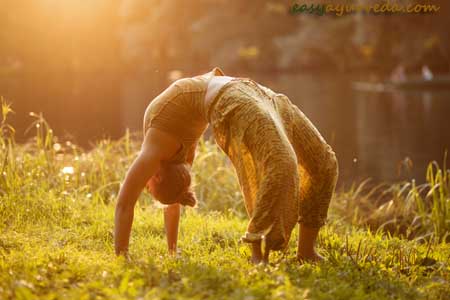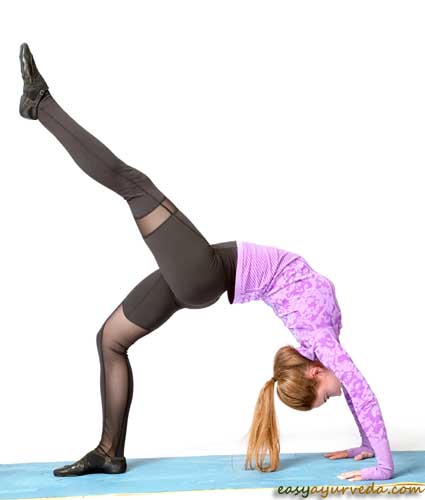Chakrasana (Urdhwa Dhanurasana) Wheel Pose, Method, Benefits, Side Effects
Article by Dr Raghuram Y.S. MD (Ay) & Dr Manasa, B.A.M.S
Chakrasana is an Asana in which the doer assumes the shape of a wheel. Therefore it is called wheel pose.Meaning –
Chakra = Wheel
Asana = Pose, Posture
Alternate Name –
Urdhwa Dhanurasana – Chakrasana is also called by the name Urdhwa Dhanurasana.
Urdhwa = Upward
Dhanu or Dhanus = Bow
Asana = Pose, Posture

Urdhwa Dhanurasana is also called as the ‘Upward Facing Bow Pose’ because the pose which the doer takes in performing the asana resembles a bow which is facing in an upward direction.
Table of Contents
Salient features
Salient features of Chakrasana or Urdhwa Dhanurasana
- Chakrasana or Urdhwa Dhanurasana is an asana which is basically a backbend.
- It forms a part of the trailing off exercises in Ashtanga Yoga regimen.
- It is one of the best asanas which is performed by those seeking strength and great flexibility of the spine
- It is known to revitalize the force surrounding the heart and the distributive force that is all over your body (prana and vyana vayus or energies). By doing so, it helps you become more aware of things and also to build courage to fight against all challenges of life.
- The asana focuses on flexing the frontal part of the body including your shoulders, intercostals muscles, wrists, flexors of hips and quadriceps muscles. It strengthens and stabilizes the shoulders, wrists, arms and sacral joints. It helps to rotate thighs and arms and also the hamstring muscles.
- It is also done as a part of acrobatics or gymnastic practices. In this case it is popularly called as back bridge.
Preparation for Chakrasana
- Chakrasana should be performed on empty stomach.
- Eat your food 4-6 hours before performing Chakrasana.
- Also evacuate your bowel and bladder before taking up this pose.
- Early morning is an ideal time to do Chakrasana.
- In case doing this asana doesn’t fit into your schedule, you can also plan to do it in the evening time.
Method
Method of doing Chakrasan
Positioning for the Asana
- Lie flat on your back on the floor.
- You may bend your knee joints such that the feet are drawn close to your butts while the soles rest on the floor.
- Feet should be hip-width apart
Performing and getting to the Chakrasana / Urdhwa Dhanurasana pose
- Place your hands behind your shoulders such that the palms are facing and pressing the floor with your fingers opened up. See that the fingers (tips) should be pointing towards the shoulders or feet and not away from the shoulders.
- Make yourself comfortable in this stance.
- Balance your body weight on your limbs.
- Now press your feet and palms on the floor. As you press your feet and palms gradually lift your entire body off the floor, slowly breathing in. Straighten the neck and keep it long while letting your head hang gently. While lifting the body, do not hurry and lift it all of a sudden. Firstly lift your hip and pelvis part off the floor, then the middle back and finally the upper back followed by neck and head. Do not flex your elbows.
- You have now gained the shape of a chakra or wheel / urdhwa dhanus or the upward facing bow
- Make sure to breathe comfortably, Take slow deep breaths while keeping your-self comfortable in this posture.
- Now you can do a little extended act. Keeping your feet still and firm on the ground, walk over your hands towards the feet, as much as you can. This will give you a good stretch.
- Be in that position for a minute or as long as you are comfortable to do it.
- Now slowly walk back on your hands to the point where you have started.
Release from the asana and coming back to the point of start
- Now gradually bring your head down to the floor while flexing your elbows. Rest your head and neck on the floor.
- Next, slowly bring your upper back, middle back and then the lower back to the floor.
- Stretch both your legs (lower limbs).
- Extend your upper limbs (hands) and bring it to the sides of your body.
- Lie down in the same posture or Shavasana for few minutes before resuming normal activities or before continuing with your workout.

Advanced pose
Advanced pose (variant of Chakrasana / Urdhwa Dhanurasana)
Eka Pada Chakrasana / Urdhwa Dhanurasana – From the Chakrasana, one leg is lifted high up into the air, while balancing the weight of the body on another leg.
Eka Hasta Chakrasana / Urdhwa Dhanurasana – From the Chakrasana posture, one arm (upper limb) is gradually raised off the ground and placed on the thigh or knee.
Purva Asanas
Purva Asanas (Preparatory Asanas)
Before Chakrasana / Urdhwa Dhanurasana, you can do one or more of the below mentioned Asanas –
- Bhujangasana
- Setu Bandha Sarvangasana
- Urdhwa Mukha Svanasana
- Virasana
Paschat Asanas
Paschat Asanas (Post-Chakrasana / Urdhwa Dhanurasana Poses)
After performing Chakrasana or Urdhwa Dhanurasana, one can perform –
- Ardha Matsyendrasana
- Supra Padangushtasana
What time should be spent in the pose while doing Chakrasana / Urdhwa Dhanurasana?
Chakrasana or Urdhwa Dhanurasana can be done for a time period stretching between 1-5 minutes depending on your capacity.
Health Benefits
Health Benefits of Chakrasana / Urdhwa Dhanurasana
Below mentioned are the benefits of Chakrasana / Urdhwa Dhanurasana –
- It expands the chest and lungs
- Provides good stretch to your lungs and chest
- Strengthens legs, butts, spine, shoulder blades, gluteal and hamstring muscles, low back, wrists, arms, upper limbs and abdomen
- Gives good stretch to flexor muscles of your hip and wrists, helps in proper flexion and movement of these joints
- Good relief to low back pain
- Good cure for asthma and infertility
- Cures osteoporosis
- It is known to stimulate pituitary and thyroid glands and balances their functions
- Good stress reliever
- Cures depression
- Provides energy and revitalizes your system, keeps you fit and healthy
Impact on Chakras
Chakrasana can introduce our conscious awareness to the chakras – cluster of dormant energies, hence the name Chakrasana.
We cannot find the mention of Chakrasana in hatha yoga texts like Hatha Yoga Pradipika, Vashishta Samhita and Goraksha Samhita. But the ancient Tantric tradition and Kundalini Yoga has held this Chakrasana in the highest regard.
In Tantric tradition of Sri Vidya, Chakrasan is used for Shakti Chalana or method of awakening the Kundalini Shakti, the primordial pool of energy and intelligence that resides in the human body. In its advanced stages, Chakrasana is used for Granthi Bhedana, the piercing of 3 knots (special points of latent energy in the body) and assists Kundalini in awakening from her timeless slumber.
Contraindications and precautions
Who should not do? (Contraindications and precautions for doing Chakrasana / Urdhwa Dahanurasana)
Patients suffering from below mentioned conditions should avoid doing Chakrasana –
- Tendon inflammation or injury in the wrists (tendonitis)
- Carpal Tunnel Syndrome
- Shoulder impingement
- Headache
- Hypertension (high BP)
- Hernia
- Diarrhea
- If your back hurts while in this posture, immediately stop doing the asana
Effect on Doshas
Effect of Chakrasana on the Doshas and their subtypes
Chakrasana balances Prana and Vyana Vayu – Since Chakrasana helps in expanding the chest and lungs, it helps in balancing Prana and Vyana Vayus, provides strength to the respiratory apparatus, cures asthma and helps in oxygenation of the body.
Balances Prana Vayu – Sadhaka Pitta axis, synchronizes their activities – Chakrasana synchronizes the activities of Prana Vayu and Sadhaka Pitta. Chakrasana stimulates pituitary and thyroid glands functions, these functions fall in the category of the mentioned dosha subtypes (Prana Vayu and Sadhaka Pitta). By doing so, Chakrasana relieves stress and cures depression, provides energy and revitalizes your system.
Effect on Dhatus
Effect of Chakrasana on Dhatus
Strengthens Asthi Dhatu, provides flexibility of Asthi Sandhis – Chakrasana strengthens the bones, especially those of the spine (vertebrae) and makes them flexible, produces easy movements. It also strengthens the bones of upper and lower limbs, increases flexibility of shoulder joints, hips, wrists and sacral joints. It thus helps in treatment of osteoporosis.
Strengthens and tones up Mamsa Dhatu – Chakrasana tones up many muscles of the body and provides flexibility in them, while strengthening them. It strengthens the thigh and arm muscles, hamstrings and quadriceps muscles and intercostals muscles.
Just Before Finish
Chakrasana or Urdhwa Dhanurasana is one of the best exercises and poses to strengthen and stretch the spine and lower limb and also to revitalize our system including Prana and Vyana energies. It also awakens the Kundalini Shakti and brings about Chakra imbalances, and balances the energy systems of our body.
In this article I have touched upon the details of doing Chakrasana / Urdhwa Dhanurasana along with its benefits on body-mind health.
Click to Consult Dr Raghuram Y.S. MD (Ayu) – skype and email








